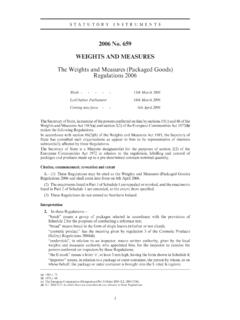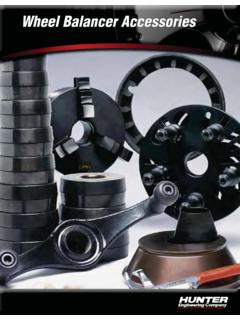Transcription of 1.5.1 AVERAGE WEIGHT REGULATIONS - UK Weighing …
1 UK Weighing Federation Technical Articles Version August 12 Page 1 of 5 Section: AVERAGE WEIGHT REGULATIONS AVERAGE WEIGHT REGULATIONS General Packaged goods may be produced by WEIGHT or by volume as appropriate, these notes only consider quantity checking by WEIGHT . With the proper conversions, goods packed by volume may be checked by WEIGHT but the conversion factors used are the responsibility of the packer. The Weights and Measures (Packaged Goods) REGULATIONS 2006 came into force on 6th April 2006. The previous legislation, contained in Part V of the Weights and Measures Act 1985 and The Weights and Measures (Packaged Goods) REGULATIONS 1986, was repealed by these new REGULATIONS . The 2006 REGULATIONS apply to all packages made up in quantities of 5g to 25kg, where the packer intended all the packages to be of the same nominal quantity, whereas the old REGULATIONS specified Prescribed Goods which were subject to the REGULATIONS , whilst other goods not in the prescribed list could be packed to the AVERAGE system on a voluntary basis.
2 The new REGULATIONS therefore have a much wider scope than the previous legislation. Types of checkweigher The type of checkweigher used following a packing operation may be automatic or manual. Automatic checkweighers are capable of checking every package at high speed and they have the advantage that they can be integrated into the filling operation to provide feedback of the accuracy of the fill, this will allow for any drift in the dispensing operation. Any packages which are outside the tolerances can be automatically rejected to ensure that no under tolerance packs enter the supply chain. These checkweighers will usually have an integrated statistical package so that production records can be automatically produced to demonstrate compliance with the legislation. Manual checkweighers are used where samples of the production process are checked using a non-automatic instrument.
3 Data collection systems, either stand-alone or integrated, can be used with manual checkweighers to simplify the task of analysing the data. The law for packers The Weights and Measures (Packaged Goods) REGULATIONS 2006 (SI 2006 No 659) contains the requirements that packers have to meet. The REGULATIONS cover the making up and marking of packages. Previous REGULATIONS defined the type of Weighing equipment that could be used for making up and checking packages, this has now been replaced with a simplified requirement that packers use equipment which is suitable for the purpose. An additional change is to remove the distinction that previously existed between equipment used for making up packages and that is used for checking them. Under the old legislation, packers had to use prescribed and verified equipment for making up packages but could use unverified equipment for checking; now any equipment used for making up or checking packages must comply with all relevant weights and measures legislation, including European Directives such as the Non-automatic Weighing Instruments Directive and the Measuring Instruments Directive.
4 However, packers who were legitimately using unverified equipment for checking packages before these REGULATIONS were introduced can continue to use that equipment without the need to have it verified. UK Weighing Federation Technical Articles Version August 12 Page 2 of 5 Section: AVERAGE WEIGHT REGULATIONS Guidance A document entitled Code of Practical Guidance for packers and importers No1 was produced to provide guidance on the previous REGULATIONS to packers and importers. Certain parts of the Code were given statutory effect by means of references in the REGULATIONS , this has not been reproduced in the 2006 REGULATIONS and many parts of the Code are now irrelevant. However, the Code still contains reference material, particularly in the Appendices that may be helpful in understanding of AVERAGE quantity control in general.
5 The Guidance provided on the 1986 REGULATIONS is, however, no longer relevant. BIS have published Guidance Notes to the 2006 REGULATIONS which can be downloaded from the BIS website. When a packer is using an automatic checkweigher the necessary records are usually part of the operation of the system. When using a non-automatic Weighing instrument, the packer will need to have a documented sampling scheme and must maintain records of the samples. The guidance document makes recommendations about the sampling plans which can be used when samples are taken from production and also shows how the data can be analysed. It is the duty of the packer to ensure that the equipment used for making up and checking packages remains accurate at all times. It is accepted that for any given filling process there will always be some deviation of the pack to pack fill value.
6 The legislation sets limits on these small deviations to ensure that they are within acceptable limits. An important concept is the Tolerable Negative Error or TNE, which is calculated from the nominal quantity being packed; see table below from schedule 3 of the 2006 REGULATIONS . Nominal quantity in grams or millilitres Tolerable Negative Error (TNE) As a percentage of nominal quantity g or ml 5 to 50 from 50 to 100 from 100 to 200 from 200 to 300 from 300 to 500 from 500 to 1,000 from 1,000 to 10,000 from 10,000 to 15,000 above 15,000 9 - - 3 - - 1 - - 9 - 15 - 150 - It can be seen from the table that as the nominal quantity increases, the banding of the TNE alternates between a fixed value and a percentage of the nominal WEIGHT . The graph below shows the effect of the banding over the 5g to 500g range. UK Weighing Federation Technical Articles Version August 12 Page 3 of 5 Section: AVERAGE WEIGHT REGULATIONS 10020030040050050 Nominal packquantityTNED ecreasing WEIGHT When calculating the values for the percentage bands, the TNE should be rounded up to the nearest Given a nominal quantity and a TNE the tolerance limit, T1 and the absolute tolerance limit, T2 can be calculated.
7 Any package whose contents are less that the nominal quantity minus the TNE is referred to as a non-standard package . The three packers rules (taken from regulation 4 of the 2006 REGULATIONS ) are: (1) the contents of the packages shall not be less on AVERAGE than the nominal quantity; (2) the proportion of packages having a negative error greater than the tolerable negative error shall be sufficiently small for batches of packages to satisfy the requirements specified in Schedule 2 [of the REGULATIONS ]; (3) no package shall have a negative error greater than twice the tolerable negative error. Note that previous REGULATIONS have given an explicit limit of in rule 2 for the proportion of packages below T1, whereas the 2006 REGULATIONS give varying limits depending on the method of sampling and the sample size. However, in all cases in schedule 2, the acceptable limits equate to a value greater than A graphical illustration of the T1 and T2 tolerance levels is given below.
8 This shows the classic normal distribution of package weights from a filling system. UK Weighing Federation Technical Articles Version August 12 Page 4 of 5 Section: AVERAGE WEIGHT REGULATIONS T1T2 Not more than ofpackages may be lessthan the TNENo packages may beless than 2 x the TNEN ominalQuantity Equipment Equipment used for making up packages, or for checking them after making up, must be suitable for the purpose and must comply with other relevant metrology legislation. The 2006 REGULATIONS differ from the previous legislation in that there is no detailed description in the type of equipment that is permitted to be used. The determination of whether a particular piece of equipment is suitable will depend on the circumstances of the case and the nominal quantity of the product being packed. The size and capacity of the equipment must bear a sensible relationship in respect of the scale interval to the quantity being packed.
9 The NMO guidance notes state that equipment that enables the quantity to be determined to TNE will be appropriate. Less sensitive equipment can be used but greater allowance should then be given compensate for errors so leading to higher give away by the packer to compensate for those possible errors. Using the recommended minimum scale division of TNE, the following table can be derived: Min scale division Min TNE Pack size > 1g > 11g > 28g 1g 5g > 112g 2g 10g > 334g 5g 25g > 1667g 10g 50g > 3334g 20g 100g > 6667g UK Weighing Federation Technical Articles Version August 12 Page 5 of 5 Section: AVERAGE WEIGHT REGULATIONS Glossary Nominal quantity, Qn The quantity marked on the container. Negative error The amount by which the actual contents fall short of the nominal. Tolerable negative error, TNE The negative error in relation to a particular nominal quantity, as defined by the REGULATIONS .
10 Tolerance limit, T1 The nominal quantity minus the tolerable negative error, T1 = Qn - TNE Absolute tolerance limit, T2 The nominal quantity minus twice the tolerable negative error, T2 = Qn 2*TNE Non-standard package A package whose contents are less than the tolerance limit, T1 Inadequate package A package whose contents are less than the absolute tolerance limit, T2 Target quantity, Qt The AVERAGE contents which an operation is intending to produce. Tolerance Under Tu Packers in-house limit for under fill Tolerance Over To Packers in-house limit for overfill Minimum target quantity Qt (min) The lowest level a packer can aim the AVERAGE contents if he is to ensure compliance Range Difference between min. and max. in process unit. Standard deviation Describes the scattering of the individuals of the sample or long term. Drift Describes the scattering of the individuals of the sample or long term like standard deviation.

